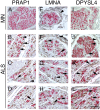Unraveling gene expression profiles in peripheral motor nerve from amyotrophic lateral sclerosis patients: insights into pathogenesis
- PMID: 27982123
- PMCID: PMC5159906
- DOI: 10.1038/srep39297
Unraveling gene expression profiles in peripheral motor nerve from amyotrophic lateral sclerosis patients: insights into pathogenesis
Abstract
The aim of the present study is to investigate the molecular pathways underlying amyotrophic lateral sclerosis (ALS) pathogenesis within the peripheral nervous system. We analyzed gene expression changes in human motor nerve diagnostic biopsies obtained from eight ALS patients and seven patients affected by motor neuropathy as controls. An integrated transcriptomics and system biology approach was employed. We identified alterations in the expression of 815 genes, with 529 up-regulated and 286 down-regulated in ALS patients. Up-regulated genes clustered around biological process involving RNA processing and protein metabolisms. We observed a significant enrichment of up-regulated small nucleolar RNA transcripts (p = 2.68*10-11) and genes related to endoplasmic reticulum unfolded protein response and chaperone activity. We found a significant down-regulation in ALS of genes related to the glutamate metabolism. Interestingly, a network analysis highlighted HDAC2, belonging to the histone deacetylase family, as the most interacting node. While so far gene expression studies in human ALS have been performed in postmortem tissues, here specimens were obtained from biopsy at an early phase of the disease, making these results new in the field of ALS research and therefore appealing for gene discovery studies.
Figures





References
-
- Cleveland D. W. & Rothstein J. D. From Charcot to Lou Gehrig: deciphering selective motor neuron death in ALS. Nat Rev Neurosci 2, 806–819 (2001). - PubMed
Publication types
MeSH terms
LinkOut - more resources
Full Text Sources
Other Literature Sources
Medical
Miscellaneous

